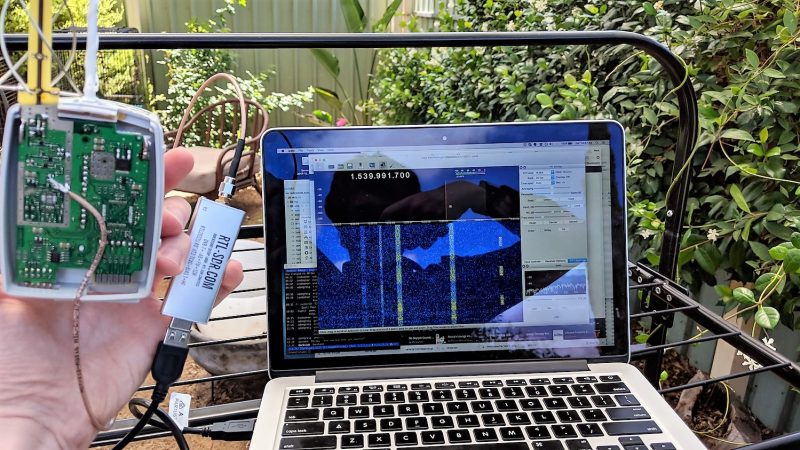If your hobby is chasing radiosondes across vast stretches of open country, and if you get good enough at it, you’ll eventually end up with a collection of the telemetry packages that once went up on weather balloons to record the conditions aloft. Once you’ve torn one or two down though, the novelty must wear off, which is where this radiosonde conversion to an active L-band antenna comes from.
As it happens, we recently discussed the details of radiosondes, so if you need a primer on these devices, check that out. But as Australian ham [Mark (VK5QI)] explains, radiosondes are a suite of weather instruments crammed into a lightweight package with a GPS receiver and a small transmitter. Lofted beneath a weather balloon into the stratosphere, a radiosonde transmits a wealth of data back to the ground before returning on a parachute after the balloon bursts. [Mark] had his eyes on the nice quadrifilar helical antenna used by the Vaisla R92 radiosonde’s GPS receiver, with the aim of repurposing them. He had a lot of components to remove while still retaining the low-noise amplifier (LNA), but in the end managed to get a working antenna with 40 dB gain in the L-band, and with the help of an RTL-SDR dongle he picked up solid signals from Iridium satellites.
Want to score your own radiosonde to play with? First, you have to know how to listen in so you can find them. Or, you know – there’s always eBay.
[via RTL-SDR.com]
















Aren’t you suppose to return them?
I found one while hunting, and called the number on the tag. Essentially they told me the number was there to reassure people that what they’d found was harmless and they told me I could keep it if I wanted. It’s still on my shelf of cool bush finds.
I found something in a foam cube last year on the farm property prior to fish camp or deer camp… I forget, photographed it and left it to see what happened next with it. It did disappear.
Here in Australia they just have a note basically saying ‘This is harmless, dispose of as is convenient, do not burn or incinerate (because of batteries)’. Given the damage these sondes often suffer on landing, it’s probably not cost-effective to re-use them.
On the other hand, the Ozone Sonde payloads (which the RS92/RS41s basically strap onto), are worth a *lot* more, and they *are* re-usable. Our local Bureau of Meteorology offers a small reward for returning those ones.
Probably varies with location. But anyone finding one should definitely check.
There was a Russian documentary on something on some desert like sandy beach north coast. They used a pressure tank that had a glass liner or something where they used some metal like zinc or iron and an acid to make the hydrogen for the weather balloon. I occasionally get the urge to hack one of those together with pipe, pipe fittings, some glass tubing with ground ends tapered ends (not sure if required as long as doesn’t spill, though seems better to for the steel portion longevity) some more fitting, connectors a pressure gauge and valve with tip and just launch a balloon to track. I am planning this urge out better however for more to enjoy the experience… with rockets too!
Why does it have to be done at pressure? Can’t you do it at atmospheric pressure? I have hydrogen with sodium hydroxide, water and aluminium foil. Ok for a test and the balloon floated but the gas had lots of liquid vapor in and should have been dried. If you wanted to do it at pressure stainless steel would work.
Good thinking David. I was thinking for storage or fill and forget and was thinking like you about how to dry to prevent corrosion.
On demand use, though doesn’t really matter unless you need the pressure to fill say a rubber balloon or a larger balloon. The vapor could be corrosive also (maybe test pH with litmus paper or hacked pH indicator).
To dry we can use some sort of hacked scrubber container, i.e. maybe a mason jar with two holes in the lid, an exhaust pipe where the tube is barely inserted into the jar, an intake pipe going into the jar just above the bottom (you could even use a watering spout or shower head to distribute the gas along the diameter of the bottom… where the jar is filled maybe 3/4’s full of a desiccant like silica gel (kitty litter), calcium sulfate, or calcium chloride (road salt) over the inserted intake tube.
A color changing indicator can help in determining when the desiccant is saturated so can be placed in the oven or over a heater to be dried and re-used again.
BOM considers them a single-use disposable device. They don’t go chasing them or expect you to return them.
It’s almost certainly different in Europe.
I saw what I think was a radiosonde in Germany many years ago. It had the usual ‘pseudo-nazi’ warning label common at the time. Government property, Do not photograph, inspect, open, (fold, spindle, mutilate). To be returned on pain of prosecution and imprisonment, etc.
I don’t know how much of that is still true. They certainly don’t use those sort of warning labels any more.
The name is “Vaisala”, not “Vaisla”
Pre-GPS sondes were tracked by a radar at the launch site. It was a bit tricky getting the radar to lock onto the ascending sonde.
Not much trickier than tracking sondes and pilot balloons optically, which is how I learned how to do it many moons ago.
You got me all excited when you wrote the helical antenna had 40 dB gain. But it’s the amplifier which has 40 dB gain; the antenna itself, maybe 6-10.